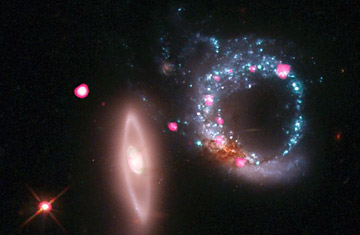
A giant ring of black holes were recently discovered about 430 million light years from Earth
It's known as Arp 147 — object number 147 in astrophysicist Halton Arp's Atlas of Peculiar Galaxies. For years, astronomers have known that it's really two galaxies that smashed through each other millions of years ago.
The collision didn't destroy either of the massive star clusters, but it did send massive shock waves rocketing outward in both, compressing sparse interstellar gas at their leading edges. That caused the galaxies to burst into light as rings of newly formed stars, spanning tens of thousands of light-years.
The pair looks spectacular enough — especially the right-hand galaxy — when photographed in ordinary light. But the cosmos glows with kinds of light our eyes can't see, all the way from radio waves up through infrared, ultraviolet and X-rays.
And when you look at Arp 147 with X-ray vision, as the orbiting Chandra X-Ray Observatory can, something else appears: the telltale glow of black holes, studded around the circle of stars like diamonds on a ring. (In this picture, a composite of Hubble and Chandra images superimposed, they show up in pink.) The black holes come from massive stars created by the shock wave, which have already sped through their life cycles and collapsed into the universe's ultimate vacuum cleaners. Black holes being black, it isn't the objects themselves that astronomers see; instead, it's surrounding gases being sucked into the holes, heated up to millions of degrees as they go.
All of that cosmic violence seems comfortably far away: Arp 147 is about 430 million light-years from Earth (that's 2 billion trillion miles, give or take), in the constellation Cetus. But we're not as safe as we think. The Milky Way is currently on a slow collision course with Andromeda, the spiral galaxy that sits practically next door in astronomical terms. In five billion years or so, the two will probably collide — and when that happens, our home galaxy could go through some wrenching changes of its own.
